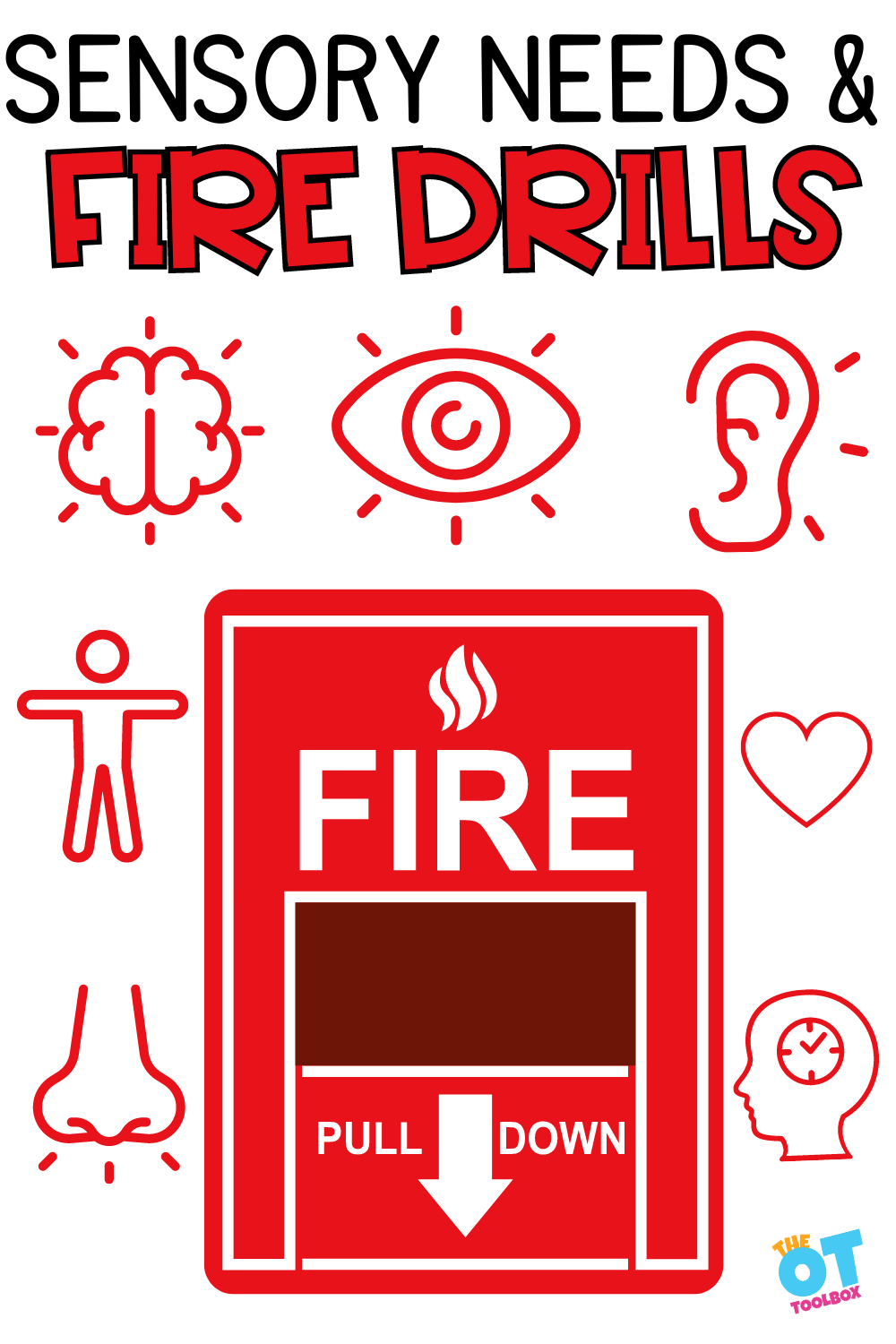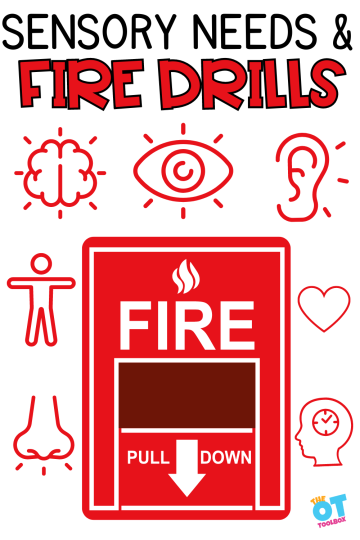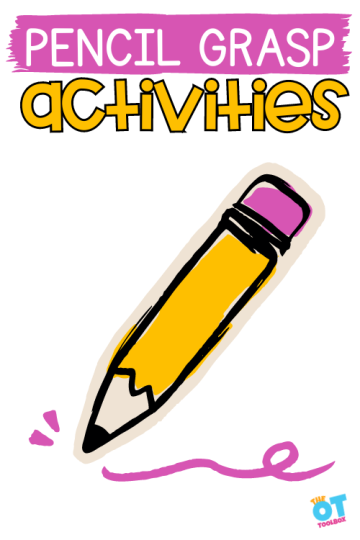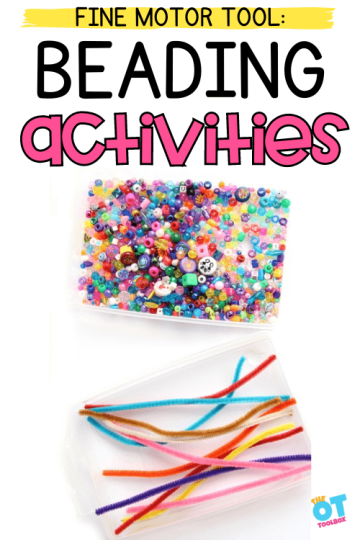This blog post was originally written in February 2023. We’ve updated the post February 2024 to target messy handwriting with a specific guide to move from sloppy handwriting to neat and legible written work.
School-based occupational therapy practitioners often hear about students with bad handwriting. Similarly, pediatric OTs and OTAs in outpatient may hear that a new client has messy handwriting that impacts learning and the ability to read their own written work. Fixing handwriting is more than just writing drills, however. And, while we love all of the creative writing practice, it’s wonderful to know what’s really happening behind messy writing. Through occupational therapy interventions, OT professionals uncover what’s really happening behind the sloppy, illegible handwriting that we see from the surface.
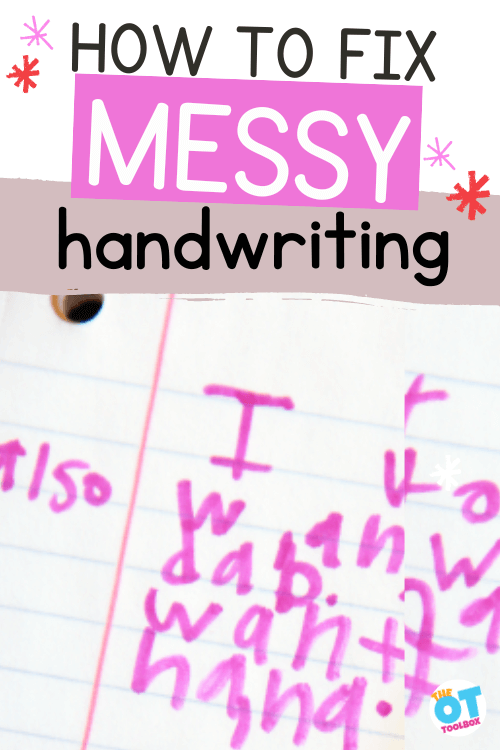
So what’s really going on behind handwriting challenges? Let’s take a deeper look…
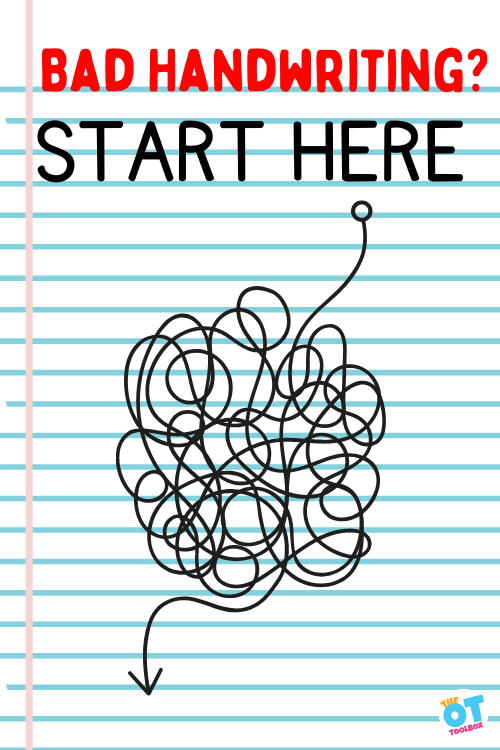
There are many things at play with messy handwriting: letter formation, placement of the letters on the paper, copying skills, speed, pencil grasp and pencil control, executive functioning, and more.
What is Messy Handwriting?
You might think one student has messy handwriting…but then you see another student’s written material that is completely illegible. When written output is illegible, we see many things that impact learning. Messy handwriting can look like:
- Inability to read own writing: Students may struggle to decipher their own handwriting, leading to frustration and hindering their ability to review and study their notes effectively.
- Difficulty for others to read: Classmates, teachers, or anyone else reviewing the student’s work may have difficulty deciphering the text, resulting in misunderstandings or delays in providing feedback.
- Spelling errors due to messy writing: Teachers may mark spelling words or answers wrong due to illegible handwriting, even if the content is correct, impacting the student’s academic performance and confidence.
- Misinterpretation of instructions: Messy handwriting can cause students to misinterpret instructions or miss important details written on the board or in handouts, leading to errors in completing assignments or assessments.
- Incomplete or inaccurate notes: Students may struggle to keep up with note-taking during lectures or class discussions because of the speed of their writing or inability to form letters with automaticity, resulting in incomplete or inaccurate notes due to messy handwriting causing them to miss key points or details.
- Trouble reading their own notes: Students may take notes in a lesson and not be able to read their work afterwards when they are studying because of the state of their writing. This can lead to missed questions on a test.
- Difficulty with organizational skills: Illegible handwriting can contribute to difficulties in organizing thoughts and information on paper, leading to disorganized assignments, messy outlines, and challenges in structuring written work effectively.
- Impact on peer collaboration: During group work or peer review activities, messy handwriting can impede effective communication and collaboration among students, leading to misunderstandings and inefficiencies in the collaborative process.
- Low self-esteem and confidence: Students with consistently messy handwriting may experience lower self-esteem and confidence in their academic abilities, affecting their motivation and willingness to engage in written tasks.
- Increased reliance on technology: Students may become overly reliant on technology for written communication (e.g., typing on a computer or using speech-to-text software) as a workaround for their handwriting difficulties, potentially limiting their development of handwriting skills and manual dexterity. Technology is a great handwriting accommodation, but there is a case for handwriting as well.
- Social implications: In addition to academic challenges, messy handwriting can also have social implications, such as embarrassment or teasing from peers, further impacting the student’s overall well-being and classroom experience.
- Illegible letter formations: Letters may be poorly formed, making it difficult to distinguish between similar letters such as ‘b’, ‘d’, ‘p’, and ‘q’.
- Inconsistent sizing: Words may vary in size and proportion, with some letters being disproportionately large or small compared to others, leading to inconsistency in readability.
- Crowded or cramped writing: Words and letters may be squeezed together, making it challenging to discern where one word ends and another begins.
- Irregular spacing: Uneven spacing between words or letters can disrupt the flow of reading and comprehension.
- Poor alignment: Lines of writing may not be straight or properly aligned with one another, causing difficulty in tracking text.
- Poor use of margins: words may run over the edge of the paper where you see the student squishing letters together as they get to the edge of the paper. Or, you may see the student moving the letters over space by space at the new line, so that the left margin gets bigger and bigger as they go down the page.
- Inaccurate baseline: The baseline, where the bottom of the letters should align, may be inconsistent, leading to a disjointed appearance and difficulty in maintaining horizontal alignment.
- Overlapping letters or words: Letters or entire words may overlap, obscuring the text and making it difficult to decipher.
- Sloppy or jagged strokes: Letters may be formed with shaky or jagged lines, resulting in unclear and messy handwriting.
- Smudging or blotting: Excessive smudging or ink blotting can obscure letters and words, further complicating readability.
- Difficulty with cursive or joined writing: Some students may struggle with connecting letters in cursive writing, leading to messy and illegible script.
The thing is that messy writing is so different and can look different depending on the individual or the task at hand.
Why do some kids have Bad Handwriting?
“OT’s are just handwriting teachers!” As an OT, this sentence totally irks me. Handwriting is an important occupation in childhood, so it is definitely something we focus on in OT. But as therapists, we know there is so much more to it than just “teaching handwriting!” Uncovering the culprits behind poor handwriting is part of the job of an OT practitioner. We start by targeting a diagnosis (or lack of diagnoses) and address the underlying considerations that lead to what we see: messy handwriting.
Some diagnoses that go hand-in-hand with sloppy penmanship may include:
- Dysgraphia
- Learning Disability
- Developmental Coordination Disorder
- Autism
- Sensory Processing Disorder or sensory challenges (exploring tactile input through sensory messy play can help with the tactile exploration.)
- ADHD
- Dyslexia
- Down Syndrome
- Cerebral Palsy
- Other physical disabilities or motor challenges
- Other diagnoses
- Non-diagnosis (meaning there does not need to be a diagnosis in place for handwriting challenges to exist!)
There is more to it than just a diagnosis, however. There are many children (and adults…) that struggle with the fine motor movements required for dexterity in written work.
And the poor motor skills required for a functional grip is a whole other story!
There are many others that are limited in the visual motor skills required to form letters or place letters on the lines when writing. Any number of considerations can lead to what we see on the surface: bad handwriting.
That’s not to say that sloppy handwriting is the end of the world! Those in the medical field are used to deciphering illegible scripts written by the hurried physician. Somehow nurses, therapists, pharmacists, and other health care providers are able to decipher the chicken scratch the must teach in medical school!
However, when bad habits with written work leads to bad handwriting it can impact learning, educational performance in the classroom, and non-functional levels of written work (or bad grades as a result of illegible handwriting).
This is when we see a need to hone in on what’s really happening under the surface of written work.
Bad Handwriting Habits
Another part of the big picture of moving from illegible writing to good handwriting skills, is considering the age and grade expectations. There may be habits that are in place that lead to messy handwriting. These sloppy writing habits can begin even in good intentions. Writing curriculum and grade level expectations in schools, I’m looking at you!
Here are some things to consider about how bad handwriting might be established. This is all part of the bigger picture, so it’s important to cover these considerations:
- Therapy providers take into consideration the development of the student based on age and other considerations. For example, in third grade, a student is expected to write on single rule lined paper, but they may not have the skills under their belt to form lowercase letters accurately in the given space with line awareness, spatial awareness, and letter size. This can mean a whole journal page is illegible because there are missing pieces in their writing experience.
- Similarly, a kindergarten student may be expected to write sentences when developmentally, they are not ready for that. However, school and grade expectations don’t take this into consideration and you have a situation where the school curriculum zooms through handwriting instruction. The child forms bad habits and the muscle memory from practicing skills before they are developmentally ready.
Other things to consider in this realm of thinking:
- Cursive handwriting is another monster- In schools, cursive letter formation is covered over the course of a few months. Depending on the curriculum, a teacher might spend one day teaching a letter. Then the student has practice pages to complete cursive practice in repetition. This is a huge area of forming a muscle memory for poor formations. They practice the letter in the classroom while copying from the board. Then one mistake on a writing worksheet leads to rows of improperly formed letters. Then, that letter is expected to be “learned” even when there is a lack of form in the practice!
- Similarly, in most situations, cursive writing isn’t required so it’s not likely that the student loses the ability to form that letter. Cursive is essentially lost after that semester of practice one time in the second grade! This is especially true for uppercase cursive letters of the alphabet.
- Preschool…Oh we can talk a lot about preschool and pre-writing that is used by preschool educators. In a word, prewriting should not be done in the preschool setting. That includes tracing, name writing, and pencil tasks of any kind. Preschool educators that are touting a writing or even a pre-writing curriculum are leading whole classrooms to a future of bad writing by establishing bad habits before the child is developmentally ready. Focus on play, coloring with crayons, and more play at this stage!
- Finally, we know that handwriting is not an easy skill to teach because it is so complex. A child’s teacher is limited to a short period in the classroom to teach actual letter stroke formation and so the other components like line use, word spacing letter spacing, size awareness, rhythm of writing, are covered only when there is a problem. The child is expected to fix mistakes on their own, or self-check rather than practice these components from the start.
What Causes Messy Handwriting?
Messy handwriting can stem from various factors, both physical and cognitive, that influence the control and coordination of hand movements required for effective penmanship.
Here are some common underlying causes of sloppy writing:
- Poor fine motor skills: Difficulties in fine motor skill, including fine motor control, which involve the precise coordination of small muscles in the hands and fingers, can result in irregular and messy handwriting. Children with underdeveloped fine motor skills may struggle to manipulate writing utensils with precision, leading to messy letter formations and inconsistent strokes.
- Weak hand muscles: Weakness in the muscles of the hands and fingers can make it challenging for individuals to maintain a consistent grip on writing utensils and control the pressure exerted during writing. Students lacking finger dexterity as a result of hand weakness can result in shaky or uneven lines, smudging, and difficulty forming clear letters. Because of the development of skills and the fine motor milestones that children progress through, we can see handwriting issues when kids are asked to write before they are developmentally ready.
- Visual-motor integration deficits: Visual-motor integration refers to the ability to coordinate visual information with motor actions, such as copying shapes or letters accurately. Difficulties in this area can manifest as poor spatial awareness and difficulty maintaining proper letter sizing, spacing, and alignment on the page.
- Poor proprioception: Proprioception is the sense of the position and movement of the body and its parts. Individuals with poor proprioceptive awareness may struggle to control the force and direction of their writing movements, leading to inconsistent letter formations and difficulty maintaining a steady hand while writing.
- Cognitive processing difficulties: Some individuals may experience challenges in cognitive processes such as attention, memory, and sequencing, which can impact their ability to organize thoughts and translate them into written form. This can result in disorganized and messy handwriting, as well as difficulties in spelling and grammar.
- Lack of exposure or practice: Insufficient exposure to handwriting practice or inadequate instruction in proper letter formation techniques can contribute to messy handwriting. Without regular practice and feedback, students may develop inefficient writing habits that persist over time.
- Emotional factors: Emotional factors such as stress, anxiety, or low self-esteem can also affect handwriting quality. Tense or anxious individuals may experience muscle tension and difficulty maintaining a relaxed grip on writing utensils, leading to increased hand fatigue and messy handwriting.
- Developmental delays or disabilities: Children with developmental delays or disabilities, such as dysgraphia or developmental coordination disorder (DCD), may exhibit persistent difficulties with handwriting despite interventions and accommodations. These conditions can impact various aspects of handwriting, including letter formation, spacing, and legibility.
There are more components that play a role in messy writing. Any one or combination of these underlying skills may lead to sloppy, messy written work.
• Form constancy
Others may not always realize the “behind the scenes” stuff going on with handwriting, or realize that a particular activity was chosen because it has many layers to it. But this is one of the reasons why I love being an OT – it’s in our nature to see the big picture!
Now, sometimes it can be tricky to find handwriting activities that meet these criteria, but don’t feel like just another writing task. Luckily, my “Fix the Mistakes” handwriting activity checks ALL these boxes!
Addressing messy handwriting requires a comprehensive approach that addresses underlying motor, sensory, and cognitive factors through targeted interventions, accommodations, and practice-based strategies.
Pediatric OTs and OTAs take all of the underlying areas into consideration when planning therapy intervention activities. They focus on the underlying areas, but also function.
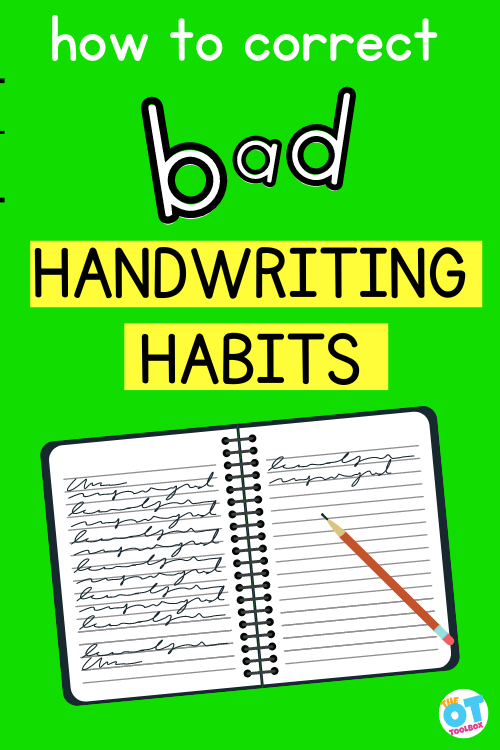
How to Fix Bad Handwriting habits
When it comes to fixing bad handwriting habits, we take a look at the underlying skills, the development of the individual, and individualized needs. We can assess what is “missing” or what bad habits might be used in written work.
Then, using specific strategies based on the needs of the child along with adaptations, modifications, and targeting specific goals can help to move from bad writing habits to functional and legible written work.
There is no sloppy writing quick fix. It takes practice and work.
A huge part of that is self-awareness and self-correction.
Working on meaningful writing tasks and then self-correcting mistakes (or fixing mistakes) is often times the missing link in the classroom setting.
WHAT IS “FIX THE MISTAKES”?
“Fix the mistakes” is exactly as it sounds – the activity provides kiddos with handwriting mistakes, which they have to fix! Students will evaluate handwriting samples that do not adhere to handwriting rules (line placement, size, spacing & letter case). Students then rewrite the sample to fix the mistakes. So, how does it meet the above criteria?
• Students hone visual perceptual skills by focusing on differences in handwriting components and attending to spatial relationships.
• Students need to use their fine motor skills to put pencil to paper and fix the handwriting mistakes.
• Students utilize executive functioning to problem solve, sequence, and utilize working memory, just to name a few.

In order for students to know what proper handwriting looks like, it is important to explicitly teach handwriting rules (such as letter formation, letter size, spacing, line placement). This activity packet includes a visual “handwriting rules” guide to assist educators with this task.
There are several different themes and bundles of writing sheets to support various interests and to help make handwriting practice engaging and motivating.
- Fix the Mistakes Fun Themes Bundle includes: Princesses, Sports, Unicorns, Space, Superheroes, and Back-to-School themes
- Fix the Mistakes Seasonal Themes Bundle includes: Winter, Spring, Summer, Fall themes
- Fix the Mistakes Holiday Themes Bundle includes: Valentines Day, St. Patrick’s Day, Easter, Halloween, Thanksgiving, and Christmas themes
- Fix the Mistakes MEGA Bundle includes all of the above themes so it’s a huge resource for covering handwriting carryover skills throughout the year.
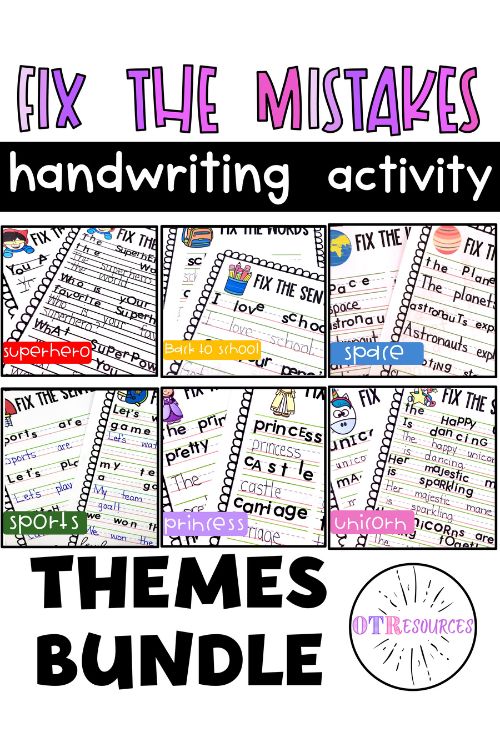


WHY IS THIS METHOD EFFECTIVE?
Kids LOVE pointing out mistakes and being able to play the role of teacher. Not only do students enjoy it, but the concepts are more easily mastered when the kiddo is able to identify and point out the errors themselves.
Fixing handwriting mistakes at different levels
One thing therapy providers do is focus on functional, better handwriting at different levels. We can do this in various ways using the strengths of the student as well as by focusing on individualized needs. Supports like use graph paper, a slant board, or using special pens and pencils can support individual needs.
The Fix the Mistakes bundles allow the therapy provider to use one bundle with a whole caseload of students because it includes writing lines for each level.
As OT’s, we know that every student has different needs. Ranging from copying individual words to copying higher-level sentences, “Fix the Mistakes” activities support that differentiation so the activity can be easily tailored to the needs of each student.
In addition to different levels, handwriting lines can be a major difference. Personally, I have found that some students respond best to 3-lines, others work very well with 2-lines, while some do best with a simple single-lined piece of paper! Every level of “fix the mistakes” has a copy of each line style – all you have to do is choose the best worksheet for your student, then print and go. Easy peasy!

